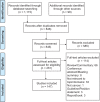How can we improve oncofertility care for patients? A systematic scoping review of current international practice and models of care
- PMID: 30462263
- PMCID: PMC6390168
- DOI: 10.1093/humupd/dmy038
How can we improve oncofertility care for patients? A systematic scoping review of current international practice and models of care
Abstract
Background: Fertility preservation (FP) is an important quality of life issue for cancer survivors of reproductive age. Despite the existence of broad international guidelines, the delivery of oncofertility care, particularly amongst paediatric, adolescent and young adult patients, remains a challenge for healthcare professionals (HCPs). The quality of oncofertility care is variable and the uptake and utilization of FP remains low. Available guidelines fall short in providing adequate detail on how oncofertility models of care (MOC) allow for the real-world application of guidelines by HCPs.
Objective and rationale: The aim of this study was to systematically review the literature on the components of oncofertility care as defined by patient and clinician representatives, and identify the barriers, facilitators and challenges, so as to improve the implementation of oncofertility services.
Search methods: A systematic scoping review was conducted on oncofertility MOC literature published in English between 2007 and 2016, relating to 10 domains of care identified through consumer research: communication, oncofertility decision aids, age-appropriate care, referral pathways, documentation, training, supportive care during treatment, reproductive care after cancer treatment, psychosocial support and ethical practice of oncofertility care. A wide range of electronic databases (CINAHL, Embase, PsycINFO, PubMed, AEIPT, Education Research Complete, ProQuest and VOCED) were searched in order to synthesize the evidence around delivery of oncofertility care. Related citations and reference lists were searched. The review was undertaken following registration (International prospective register of systematic reviews (PROSPERO) registration number CRD42017055837) and guidelines of Preferred Reporting Items for Systematic Reviews and Meta-Analyses (PRISMA).
Outcomes: A total of 846 potentially relevant studies were identified after the removal of duplicates. All titles and abstracts were screened by a single reviewer and the final 147 papers were screened by two reviewers. Ten papers on established MOC were identified amongst the included papers. Data were extracted from each paper and quality scores were then summarized in the oncofertility MOC summary matrix. The results identified a number of themes for improving MOC in each domain, which included: the importance of patients receiving communication that is of a higher quality and in different formats on their fertility risk and FP options; improving provision of oncofertility care in a timely manner; improving access to age-appropriate care; defining the role and scope of practice of all HCPs; and improving communication between different HCPs. Different forms of decision aids were found useful for assisting patients to understand FP options and weigh up choices.
Wider implications: This analysis identifies core components for delivery of oncofertility MOC. The provision of oncofertility services requires planning to ensure services have safe and reliable referral pathways and that they are age-appropriate and include medical and psychological oncofertility care into the survivorship period. In order for this to happen, collaboration needs to occur between clinicians, allied HCPs and executives within paediatric and adult hospitals, as well as fertility clinics across both public and private services. Training of both cancer and non-cancer HCPs is needed to improve the knowledge of HCPs, the quality of care provided and the confidence of HCPs with these consultations.
Keywords: communication; fertility preservation; late effects; models of care; oncofertility; survivorship; systematic review; training.
© The Author(s) 2018. Published by Oxford University Press on behalf of the European Society of Human Reproduction and Embryology.
Figures
References
-
- Abe A, Kuwahara A, Iwasa T, Nishimura M, Irahara M. A survey on fertility management in young women of reproductive age treated with chemotherapy. Int J Clin Oncol 2016;21:1183–1190. - PubMed
-
- Anazodo AC, Gerstl B, Stern CJ, McLachlan RI, Agresta F, Jayasinghe Y, Cohn RJ, Wakefield CE, Chapman M, Ledger W et al. Utilizing the experience of consumers in consultation to develop the Australasian Oncofertility Consortium Charter. J Adolesc Young Adult Oncol 2016;5:232–239. - PubMed



